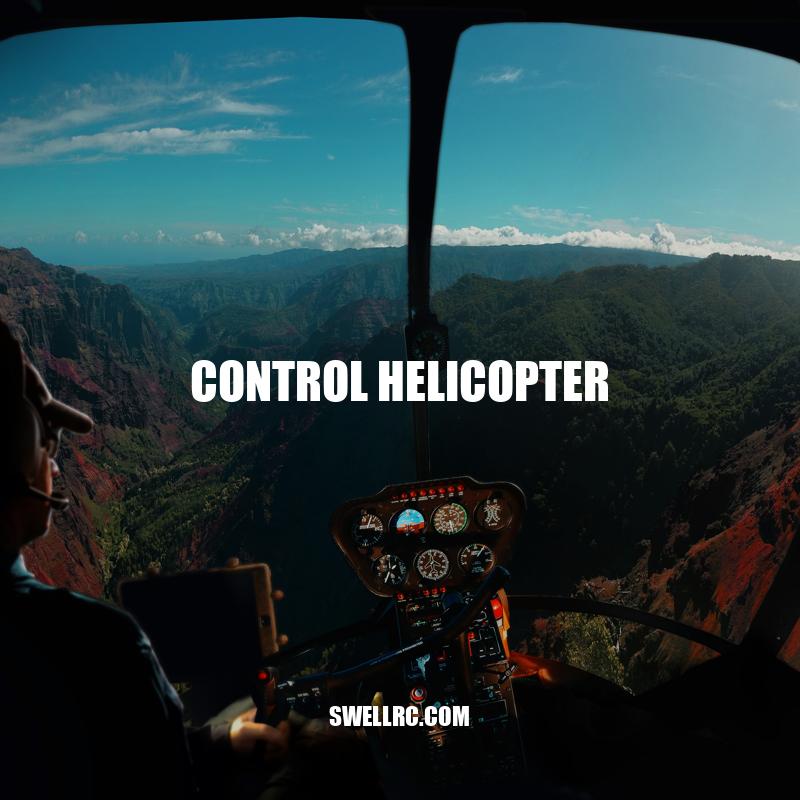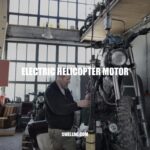Guide to Buying and Operating Control Helicopters
Radio-controlled helicopters, or control helicopters, are one of the most fascinating and exciting indoor and outdoor hobbies anyone can experience. Also known as RC helicopters, these machines come in various shapes, sizes and types. They offer a more advanced and challenging flying experience than remote-controlled planes and are now widely available to novice or professional flyers alike. From small, to mid-size and large helicopters, there is a suitable model for all skill levels and preferences. With advancements in technology and design, a person can now control their helicopter using remote or computer software from a considerable distance. Whether you’re looking for a more thrilling experience than flying a drone or just a new hobby to try, control helicopter flying can be a great choice for anyone willing to invest their time and money to gain the skill, knowledge and enjoyment of maneuvering a beautifully made miniature aircraft in the sky.
Types of Control Helicopters
There are several types of radio-controlled helicopters, each with unique features that cater to different skill levels and preferences. Here are some of the most common types you’ll come across:
- Fixed-pitch: These helicopters have a fixed angle between the rotor blades and the helicopter’s body, making them easy to control and perfect for beginners.
- Collective-pitch: These helicopters have a rotor blade angle that can be adjusted in flight, giving the flyer greater control and maneuverability. They are typically used by experienced pilots and are considered the most advanced type of control helicopter.
- Coaxial: These helicopters have two rotors on top of each other, making them more stable and easier to fly than other types. They’re often used in indoor environments and are considered a good option for beginners.
- Quadcopters and hexacopters: These helicopters have four or six rotors and are often used with a camera in aerial photography or video recording. They are easy to control and maneuver, perfect for users who want to start flying in the outdoors.
If you’re thinking of purchasing a control helicopter, consider which type of helicopter meets your needs as a user. A good place to start is through well-known online stores such as Amazon or Best Buy where you can view a wide selection of control helicopters. If you want to learn more about each type before buying, several websites, such as RC Groups or Rotor Riot offer resources to help you understand the advantages and disadvantages of each of these helicopters.
What are the controls in a helicopter?
Helicopters have a complex system of controls that allow them to move in any direction. Here’s a brief description of the main controls:
| Control | Description |
|---|---|
| Collective Pitch Control | Controls the angle of the rotor blades, changing the helicopter’s altitude |
| Cyclic Pitch Control | Controls the angle of the rotor blades, changing the helicopter’s direction by tilting it forward, backward, or sideways |
| Anti-Torque Pedals | Controls the tail rotor’s pitch, changing the helicopter’s yaw (rotation around its vertical axis) |
| Throttle | Controls the power output of the engine(s), changing the helicopter’s speed |
If you’re interested in learning more about helicopter controls and how they work, check out websites like rotor.org and helicopterflight.net for more information. You can also look into products like flight simulators to get a more hands-on experience with helicopter controls.
Factors to Consider When Buying a Control Helicopter
Before buying your first control helicopter, it’s essential to consider the purpose for which you’ll use it, the operating environment, and your skill level. Here are some factors you should consider when buying a control helicopter:
- Size: Consider the size of the control helicopter, as it directly affects its weight and portability. Small helicopters are lightweight and easy to carry around, making them ideal for both indoor and outdoor use. Large helicopters are usually more durable but are challenging to carry around.
- Skill level: Carefully consider your proficiency level when choosing a control helicopter. If you’re a beginner, opt for the fixed-pitch or coaxial helicopter models as they are easiest to control. More experienced pilots can handle the collective-pitch models, which offer more advanced features and more maneuverability.
- Battery life: Look for the battery’s run time and rechargeable options. Flight time can vary from four to fifteen minutes, depending on the type of helicopter, battery size, and brand.
- Cost: Control helicopters can range from inexpensive to extremely expensive. Price is based on the quality of the model, the number of features, and its level of customization. Consider how much you want to spend at the outset and evaluate how long the helicopter will last before upgrading or repairing it.
To find a control helicopter that fits best with your personality and interests, you can consult online marketplaces, such as Amazon or Walmart, or look for specialized websites like Horizon Hobby offers the latest and most advanced models. The table below offers a side-by-side comparison of some popular control helicopters available in the market:
| Model | Size | Type | Price |
|---|---|---|---|
| Syma S107G | 19cm | Fixed-pitch | $21.99 |
| Blade 70S | 23cm | Fixed-pitch | $79.99 |
| Blade Nano S2 | 17cm | Fixed-pitch | $99.99 |
| Blade 230 S | 61cm | Collective-pitch | $369.99 |
What to Look for When Buying a Helicopter?
If you’re interested in buying a helicopter, there are a few things to consider before making your purchase. Here are some important factors to keep in mind:
- Intended use: Will you be using the helicopter for personal or commercial use?
- Budget: Helicopters can range in price from a few hundred thousand dollars to tens of millions of dollars, so it’s important to establish a budget.
- Aircraft size: Consider the size of the helicopter, as well as seating capacity and cargo space.
- Performance capabilities: Look at factors such as cruising speed, range, and altitude capabilities.
- Operating costs: Helicopters have high operating costs, so it’s important to factor in expenses such as fuel, maintenance, and insurance.
It’s also important to work with a reputable dealer or broker who can guide you through the buying process. Websites such as Controller.com and Trade-A-Plane.com can be useful resources for locating helicopters for sale.
Operating a Control Helicopter
Operating a control helicopter can be a fun but challenging experience, especially for first-timers. Here are some tips to help you operate your control helicopter efficiently:
- Charge the batteries: Before you start flying, make sure the helicopter’s batteries are fully charged. Read and follow the instructions that come with the helicopter to avoid damaging the battery or the helicopter.
- Know your controller: Familiarize yourself with your controller by reading the manual carefully. Every controller is different, so it pays to know which button does what before attempting to fly the helicopter. Understanding the controller’s features will make it easier for you to control the helicopter during flight.
- Start slow: Start on a flat and open surface, indoors or outdoors, and gently move the helicopter up in the air. Practice how to hover, turn, and move it around for a few minutes until you gain more confidence to fly higher and faster.
- Be cautious of altitude: Keep the helicopter at a lower altitude as driving too high can lead to losing control. Beginners should never fly in high wind conditions, which can likewise result in losing the helicopter’s control.
- Practice makes perfect: Don’t be discouraged by crashes and failures; they are just part of the learning process. Practice regularly to improve your control skills and to increase your confidence in flying the helicopter.
Finally, to keep your control helicopter in top condition, regular maintenance is critical. You can visit websites such as HobbyTown for advice on how to maintain your control helicopter. Remember, with the right attitude, patience, and practice, operating a control helicopter can be a delightful and rewarding experience.
How hard is it to fly RC helicopter?
| Difficulty Level | Description |
|---|---|
| Easy | Flying basic toy helicopters that are designed for children aged 8 to 10 years old is relatively easy. They are usually made of lightweight materials and come with simple controls. |
| Medium | Flying mid-level RC helicopters like the Blade 230S is harder and requires some practice. These helicopters are more responsive and agile, making them less forgiving of pilot errors. |
| Hard | Flying high-end RC helicopters like the Align T-Rex 700X requires significant expertise. These helicopters are designed for advanced pilots and come with complex controls and features. |
- RC helicopters are available in different price ranges, from budget-friendly options to high-end models.
- Practice is essential for mastering the art of flying an RC helicopter.
- Many websites offer guides, tutorials, and videos to help beginners get started with RC helicopters.
Maintenance and Troubleshooting
Maintenance is essential for prolonging the lifespan and ensuring the proper functioning of your control helicopter. Here are some tips for maintaining and troubleshooting your control helicopter:
- Cleaning: Dirt, dust, and debris can clog the helicopter’s motor and cause it to malfunction. Clean the helicopter regularly using a soft cloth to remove any material that may impair the aircraft’s functions. Avoid using water or other liquids to clean the motor or the helicopter’s electronics as they are sensitive to moisture.
- Inspection: Perform a thorough inspection of the helicopter before each flight. Check the rotor blades, the fuselage, and the electronics for any signs of wear or damage. Replace any parts that show signs of wear or damage to avoid accidents or the destruction of the helicopter.
- Repairs: If your helicopter sustains damage during use, troubleshoot the problem first, and determine whether you need professional help or if you can fix it yourself. Many basic repairs, such as replacing a blade or a motor, can be done at home using appropriate tools and referring to user manuals.
If your control helicopter experiences technical issues that you are unable to troubleshoot or fix, it is recommended to take it to a professional for inspection and repairs. Websites such as Tower Hobbies offer a range of helpful resources for maintaining and troubleshooting your control helicopter, as well as a wide variety of parts and accessories to help you enhance your control helicopter’s performance. Remember, regular maintenance can reduce the likelihood of technical issues and accidents and ensure that your control helicopter continues to function correctly.
How do you control a helicopter drone?
To control a helicopter drone, you will need a remote control or transmitter that communicates with the drone’s onboard computer. Below are the steps to control a helicopter drone:
- Make sure the drone and the remote control are turned on and properly connected.
- Use the joystick to control the drone’s altitude, direction, and speed.
- Read the user manual carefully and learn the specific functions of each button and switch on the remote control.
- Practice flying the drone in an open, safe, and legal area.
To get more information about controlling a helicopter drone, you can visit websites like DJI.com or QuadcopterHQ.com. These websites offer a wide range of drone products and helpful tutorials for beginners and professionals.
Safety Tips
Operating a control helicopter comes with inherent risks and requires a certain level of responsibility. Here are some safety tips to keep in mind while operating your control helicopter:
- Protective equipment: Wear appropriate protective equipment, such as goggles, gloves, and a helmet, to avoid injuries from spinning rotors or flying debris.
- Location: Ensure that you operate your control helicopter in a safe and open location, away from pedestrians, vehicles, trees, and other potential obstacles.
- Weather: Avoid flying your control helicopter in adverse weather conditions, such as high wind or rain, as it can cause the helicopter to malfunction and become difficult to control.
- Regulations: Adhere to local regulations and guidelines on operating control helicopters. Avoid flying in restricted areas and respect the privacy of others.
In addition to these safety tips, it is recommended to consult with experienced control helicopter pilots and online forums to learn more about safety practices and regulations. Websites such as HeliFreak offer a wealth of resources and forums for control helicopter enthusiasts to learn, ask questions, and share their experiences. Remember, safety is key in enjoying this rewarding hobby.
How do you operate a helicopter?
Operating a helicopter requires specialized training, certification, and experience. Here are some essential steps to operate a helicopter:
- Conduct a pre-flight check to ensure that the helicopter is in good working condition, including checking its fuel and oil levels, and inspecting the rotor blades and instruments.
- Consult the helicopter’s operating manual to familiarize yourself with the controls, such as the collective, cyclic, and pedals.
- Start the engine and allow it to warm up before taking off.
- Use the collective to lift the helicopter off the ground and vary the pitch of the rotor blades to control its altitude.
- Use the cyclic to control the helicopter’s direction of travel, and the pedals to control its yaw.
- Monitor the helicopter’s gauges and instruments throughout the flight to ensure that it is operating safely and efficiently.
It’s important to note that operating a helicopter is a complex task and should only be attempted by trained professionals. Websites such as Helicopter Pilot Ground School and products like Microsoft Flight Simulator can offer further guidance and training for those interested in learning how to operate a helicopter.
Conclusion
Control helicopters offer an exciting and rewarding hobby for enthusiasts of all levels. Whether you’re a beginner or an experienced pilot, learning to operate and maintain a control helicopter requires patience, dedication, and a commitment to safety. By choosing the right helicopter, mastering the controls, and following proper safety practices, you can enjoy hours of fun and challenging flights with your control helicopter. Remember to also stay up to date on the latest regulations and guidelines for safe and responsible operation. With practice and perseverance, you can become a skilled control helicopter pilot and enjoy this thrilling hobby for years to come.



